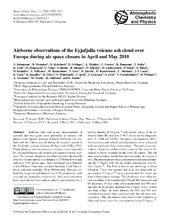| dc.contributor.author | Schumann, U. | |
| dc.contributor.author | Weinzierl, B | |
| dc.contributor.author | Reitebuch, O | |
| dc.contributor.author | Schlager, H. | |
| dc.contributor.author | Minikin, A | |
| dc.contributor.author | Forster, C | |
| dc.contributor.author | Baumann, R | |
| dc.contributor.author | Sailer, T | |
| dc.contributor.author | Graf, K | |
| dc.contributor.author | Mannstein, H. | |
| dc.contributor.author | Voigt, C | |
| dc.contributor.author | Rahm, S | |
| dc.contributor.author | Simmet, R | |
| dc.contributor.author | Scheibe, M | |
| dc.contributor.author | Lichtenstern, M | |
| dc.contributor.author | Stock, P | |
| dc.contributor.author | Ruba, H | |
| dc.contributor.author | Schauble, D | |
| dc.contributor.author | Tafferner, A | |
| dc.contributor.author | Rautenhaus, M | |
| dc.contributor.author | Gerz, T | |
| dc.contributor.author | Ziereis, H | |
| dc.contributor.author | Krautstrunk, M | |
| dc.contributor.author | Mallaun, C | |
| dc.contributor.author | Gayet, JF | |
| dc.contributor.author | Lieke, K | |
| dc.contributor.author | Kandler, K | |
| dc.contributor.author | Ebert, M | |
| dc.contributor.author | Weinbruch, S | |
| dc.contributor.author | Stohl, Andreas | |
| dc.contributor.author | Gasteiger, J | |
| dc.contributor.author | Gross, S | |
| dc.contributor.author | Freudenthaler, V | |
| dc.contributor.author | Wiegner, M | |
| dc.contributor.author | Ansmann, A | |
| dc.contributor.author | Tesche, M | |
| dc.contributor.author | Ólafsson, Haraldur | |
| dc.contributor.author | Sturm, K | |
| dc.date.accessioned | 2016-08-03T12:44:04Z | |
| dc.date.available | 2016-08-03T12:44:04Z | |
| dc.date.issued | 2011-03-11 | |
| dc.Published | Atmospheric Chemistry and Physics 2011, 11(5):2245-2279 | eng |
| dc.identifier.issn | 1680-7324 | en_US |
| dc.identifier.uri | https://hdl.handle.net/1956/12423 | |
| dc.description.abstract | Airborne lidar and in-situ measurements of aerosols and trace gases were performed in volcanic ash plumes over Europe between Southern Germany and Iceland with the Falcon aircraft during the eruption period of the Eyjafjalla volcano between 19 April and 18 May 2010. Flight planning and measurement analyses were supported by a refined Meteosat ash product and trajectory model analysis. The volcanic ash plume was observed with lidar directly over the volcano and up to a distance of 2700 km downwind, and up to 120 h plume ages. Aged ash layers were between a few 100 m to 3 km deep, occurred between 1 and 7 km altitude, and were typically 100 to 300 km wide. Particles collected by impactors had diameters up to 20 μm diameter, with size and age dependent composition. Ash mass concentrations were derived from optical particle spectrometers for a particle density of 2.6 g cm−3 and various values of the refractive index (RI, real part: 1.59; 3 values for the imaginary part: 0, 0.004 and 0.008). The mass concentrations, effective diameters and related optical properties were compared with ground-based lidar observations. Theoretical considerations of particle sedimentation constrain the particle diameters to those obtained for the lower RI values. The ash mass concentration results have an uncertainty of a factor of two. The maximum ash mass concentration encountered during the 17 flights with 34 ash plume penetrations was below 1 mg m−3. The Falcon flew in ash clouds up to about 0.8 mg m−3 for a few minutes and in an ash cloud with approximately 0.2 mg m−3 mean-concentration for about one hour without engine damage. The ash plumes were rather dry and correlated with considerable CO and SO2 increases and O3 decreases. To first order, ash concentration and SO2 mixing ratio in the plumes decreased by a factor of two within less than a day. In fresh plumes, the SO2 and CO concentration increases were correlated with the ash mass concentration. The ash plumes were often visible slantwise as faint dark layers, even for concentrations below 0.1 mg m−3. The large abundance of volatile Aitken mode particles suggests previous nucleation of sulfuric acid droplets. The effective diameters range between 0.2 and 3 μm with considerable surface and volume contributions from the Aitken and coarse mode aerosol, respectively. The distal ash mass flux on 2 May was of the order of 500 (240–1600) kg s−1. The volcano induced about 10 (2.5–50) Tg of distal ash mass and about 3 (0.6–23) Tg of SO2 during the whole eruption period. The results of the Falcon flights were used to support the responsible agencies in their decisions concerning air traffic in the presence of volcanic ash. | en_US |
| dc.language.iso | eng | eng |
| dc.publisher | Copernicus Publications | en_US |
| dc.rights | Attribution CC BY | eng |
| dc.rights.uri | http://creativecommons.org/licenses/by/3.0/ | eng |
| dc.title | Airborne observations of the Eyjafjalla volcano ash cloud over Europe during air space closure in April and May 2010 | en_US |
| dc.type | Peer reviewed | |
| dc.type | Journal article | |
| dc.date.updated | 2016-04-07T13:45:51Z | |
| dc.description.version | publishedVersion | en_US |
| dc.rights.holder | Copyright 2011 The Authors | en_US |
| dc.identifier.doi | https://doi.org/10.5194/acp-11-2245-2011 | |
| dc.identifier.cristin | 829981 | |

